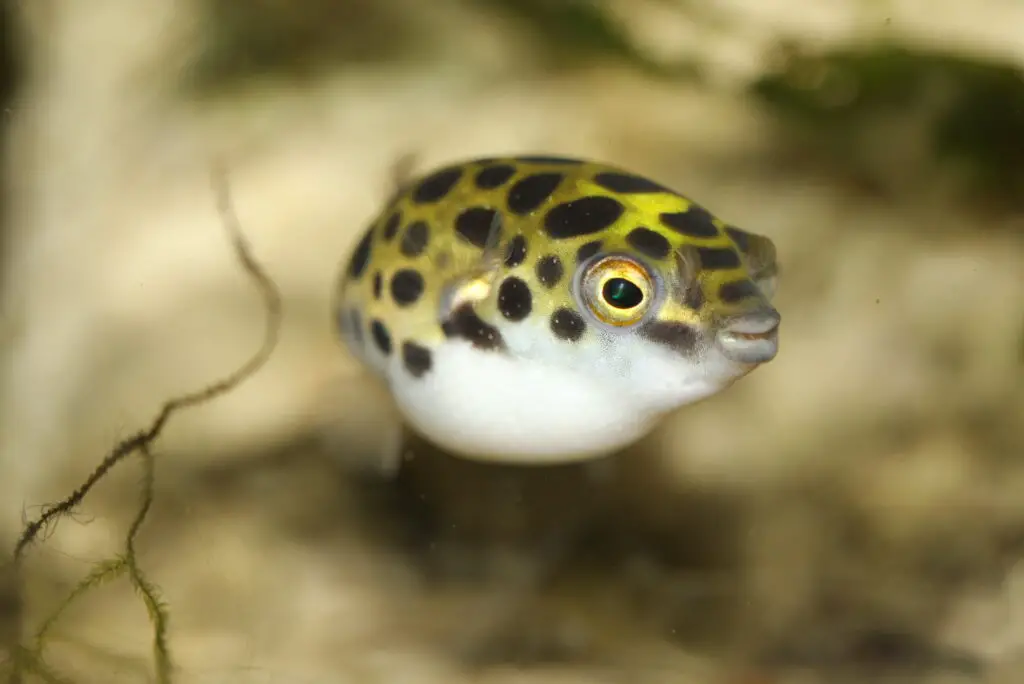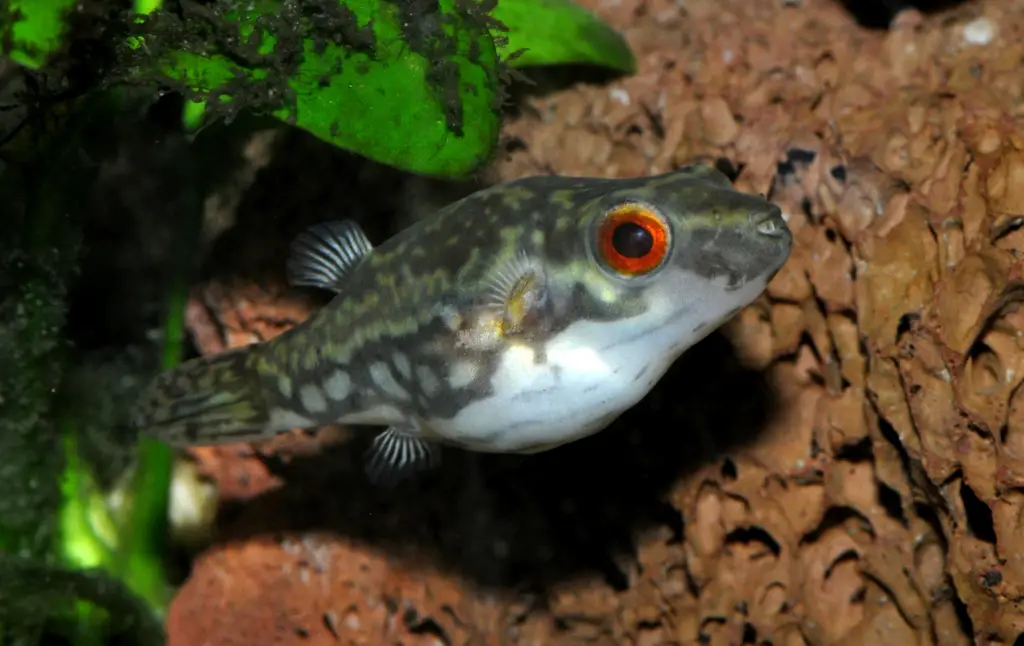You can put a freshwater puffer into your pond if it has the right parameters. Pufferfish are known to be good for your fish pond. There are four species of pufferfish: Mbu, Pea, green spotted, and Red-eyed. Learn more about these creatures and how to care for them. You can even learn about keeping them.
Pea Puffer Fish

If you want to add a new species of pufferfish to your backyard pond, you must first acclimate the new pet to the aquarium water. This process should be gradual as it may take several weeks to adjust to the new water. Adding aquarium salt to a 10-liter fish pond will help you to start the process properly. Once the tank is settled, you can introduce the new fish to its new home.
Pufferfish can tolerate nitrate levels between 20 and 40 ppm. Ideally, this should be kept at around 10 ppm. The tank should be planted with plants to help the puffers grow faster. They also need shelled creatures to survive. BB puffers love to eat shrimp, clams, and freshwater snails. Make sure to purchase the shelled creatures in raw form as prepared foods may contain harmful seasonings.
Traditional pufferfish are known to be aggressive and have decimated most aquarium plants. Choose a smaller freshwater puffer, called a Pygmy puffer or Malabar puffer, instead. These species are less likely to harm each other and aren’t psychopaths. These fish also make great pets for beginners, but you should be prepared to invest some money.
A red-eyed puffer, on the other hand, is a bit more complicated. It needs a deeper substrate and crustaceans for its diet. It will not be able to live entirely off of snails, so you must buy fresh ones. You can also add live food to your tank. It’s important to remember that they will eat snail shells, but not their heads.
If you’re unsure of whether you can safely introduce this species into your backyard fish pond, consult a marine biologist. It is important to know what they need and what habitat they prefer. The best place for them would be a sheltered rock or flowerpot. They prefer brackish water, but are also capable of living in freshwater. When you decide to add puffers to your pond, make sure you have a thriving ecosystem and plenty of food.
Red-eyed puffer fish

If you have a small fish pond, you can add a puffer fish to it. But be sure to know what they need to survive. Freshwater puffer fish can’t live in brackish water. Their shells are too hard for them to survive in freshwater. Therefore, they must be bred in brackish water. If you are planning to put a figure 8 into your fish pond, there are some things you should know.
First, you should know that pufferfish can’t live in a tank that contains any ammonia or nitrite. These gases are lethal to fish. Hence, you should cycle your aquarium before adding a puffer fish. During the cycling process, you must ensure that there is no excess of these pollutants. Moreover, it is best to add some plants to your fish pond to keep the pH levels stable.
Pufferfish are known to be shy and timid. However, if you want a beautiful pair of fish, it would be better to get a big space and decorate it well. Mbu pufferfish can grow up to almost three feet in length and eat massive quantities of shellfish. But shellfish are expensive and you should be aware of this before you buy a puffer fish for your pond.
Regardless of whether you want a small fish or a large one, you should not introduce a freshwater puffer into a tank that hasn’t been cycled. The reason for this is that freshwater puffers are brackish water fish. Despite their attractive appearance, they must be transferred to brackish water to survive. Adding a green spotted puffer to a freshwater pond will lead to the fish’s death, and that will be bad for the others in the tank as well.
If you’ve never had a puffer fish before, you should make sure to read up on the species before you buy one. The Mbu puffer fish is a unique species that requires careful handling and proper care. And remember to follow the guidelines to keep them healthy and happy. Make sure to get a 20-gallon tank, and remember to feed them hard-bodied food at least once a day.
Green Spotted Puffer Fish

If you are considering introducing green spotted puffer fish to your backyard fish pond, you might be wondering how to keep them healthy. These fish do not have scales, which makes them susceptible to several diseases. Most of these diseases are caused by dirty water, and you should therefore keep your fish tank clean to prevent them from developing these diseases. One of these diseases is ich, which manifests as cysts on the fish’s skin and gills and can result in excessive and labored breathing.
The green spotted puffer grows to 6 inches in length, and they require special care to avoid injury. The fish can live up to 15 years, but they can die young if not taken care of properly. It is a good idea to keep a few of these fish as pets. However, remember that these fish are territorial and may attack other fish in the aquarium if they feel threatened. If you give them proper care, you can get them tamed enough to feed them by hand. You should use gloves when handling them so you don’t end up suffocating them.
Puffer fish are commonly sold as freshwater fish, but they require brackish water once they reach maturity. For this reason, they should be kept in water with a specific gravity of 1.015 or higher. Many experienced hobbyists recommend that you maintain these fish in full marine conditions, as they are much easier to keep and allow for supplemental techniques. However, this species is not for everyone.
As a beginner, you shouldn’t add green spotted puffer fish to your pond without first checking out their size and determining their health. These fish are relatively easy to keep and are not difficult to care for. However, be prepared to spend a considerable amount of time observing them. A green spotted puffer can grow up to be around 6.5 inches in length.
Mbu Puffer Fish

If you have a pond and are planning to add a few fish to it, you may want to consider adding Mbu puffer fish to it. The Mbu is a large fish, so it is a good idea to feed it shelled foods like snails, clams, and mussels. Not only will this provide your new fish with a balanced diet, but it will also help to buffer the water.
Mbu pufferfish are a giant among freshwater puffers, so be sure to choose the right tank for them. Because they grow very quickly, you will want to consider having a large tank. This fish requires at least eight feet of space and a wide turning circle. It also requires a high level of filtration, as their food and water quality require high oxygenation levels.
Taking care of a Mbu puffer is a major undertaking. It’s important to follow established guidelines to make sure the fish are happy and healthy. An Mbu puffer tank should have a minimum volume of 500 gallons, which is a little too small. A higher tank volume will provide more exercise and a happier mood for the fish. In addition, you should consider the space for other fish in the tank. Mbu puffers also prefer an aquarium that’s long and wide rather than narrow and deep.
When choosing tank mates for Mbu puffer, it’s important to consider their personalities. Some of these fish are aggressive while others are docile. The right tank mate for your Mbu puffer will depend on the personality of each of the fish in the tank. Some Mbu puffer fish may be peaceful and tolerant, while others are carnivorous and aggressive.
When adding Mbu puffer fish to your pond, remember that their eyes are not as close together as other freshwater fish, and as they grow, their eyes become more distanced. Because their eyes get farther apart as they grow, they must look at their food from the side, and line up to catch it. This is important since pufferfish can be eaten by their tank mates if they swim in at the right moment.
